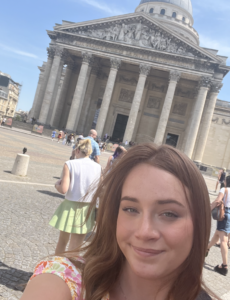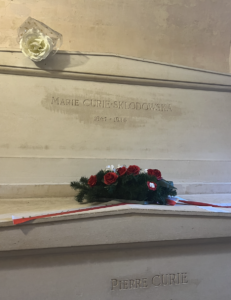I see dead people…in crypts. On Wednesday, we went to visit the Pantheon in Paris! “Pantheon” is derived from Greek, meaning ‘temple for all gods.’ However, the French Pantheon was intended not to be a religious symbol or house any religious artifacts. Instead, this Pantheon would be the resting place for those who extended the greatness of France, and assisted France in pursuing its’ national motto: liberté, égalité, fraternité (liberty, equality, and brotherhood.)


While listening to the audio tour, I learned that only men (and, more recently, women) who made their achievements after July 14, 1789, are allowed to be buried at the Pantheon. This is because only those who brought glory to France during ‘freedom’ may be buried there, and July 14, 1789, was the Storming of the Bastille that was recognized as the official beginning of the French Revolution, and every period after that was determined to be free France. This can be seen in the inscription on the first-floor reading “vivre libre ou mourir,” or “live free or die.” Some notable characters featured in the Pantheon are Joan of Arc, immortalized in a mural along the side chambers, Victor Hugo in his vault, and some enlightenment writers and philosophers such as Rosseau and Voltaire. I found it particularly intriguing how Joan of Arc, a distinctly French religious feature, could be so beautifully combined with secularism to intertwine both Christianity and secular versions of French history. Our final stop on our visit was to the tomb of Marie Curie. Marie Curie famously received radiation poisoning during her lab work, which eventually lead to her death via aplastic pernicious anaemia. During her time working with radium, she began a fleet of mobile X-ray devices to allow doctors’ to locate shrapnel wounds in soldiers’ during WWI. She then founded the Instiut du Radium, which is now an oncology research center. It made me wonder how far oncology radiation therapy has come since the time of Marie Curie. I found an article that gave an overview of the historical development of radiation therapy. Following the increase in empiricist medicinal practices, radiation therapy has grown to be more focused on local tumor destruction and reduction of side-effects. For instance, in clinical trials it was found that radiation therapy improves local control of a tumor and increases survival rates of breast cancer following first breast-conserving surgery, and then mastectomy if absolutely needed (Thompson et. al, 2018). It’s interesting to see this development in the thinking behind physiology and medicinal practices over 150 years after Curie.

References:
Thompson, M. K., Poortmans, P., Chalmers, A. J., Faivre-Finn, C., Hall, E., Huddart, R. A., Lievens, Y., Sebag-Montefiore, D., & Coles, C. E. (2018). Practice-changing radiation therapy trials for the treatment of cancer: Where are we 150 years after the birth of Marie Curie? British Journal of Cancer, 119(4), 389–407. https://doi.org/10.1038/s41416-018-0201-z
